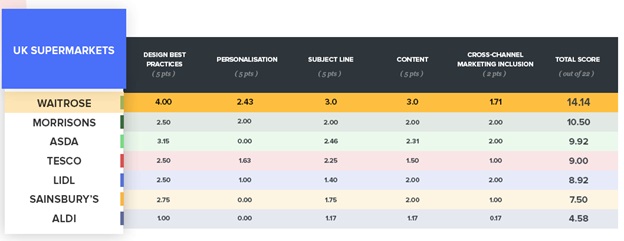Waitrose has beaten off the competition for the top spot in terms of email marketing to customer, according to new research.
The study, from email provider Mailjet, analyses emails sent by the leading seven supermarket chains in their Christmas marketing campaigns.
In the study carried out by Mailjet, Waitrose came out as the leader in four of the eight parameters measured, although the retailer scored only 14.1 out of a possible 22. The low scores across the board signal a huge missed opportunity for UK supermarkets, when it comes to engaging with customers via email.
The UK supermarkets were ranked in the following order:
1. Waitrose
2. Morrisons
3. Asda
4. Tesco
5. Lidl
6. Sainsbury’s
7. Aldi

For a breakdown on the scoring procedure and to see how each supermarket performed individually, please do take a look at the press release below as well as the infographic attached. More details can be sent upon request.
In the study carried out by marketing experts, Waitrose came out as the leader in three of the eight parameters measured, although the retailer scored only 14.1 out of a possible 22 to bag the top spot. The low scores across the board signal a huge missed opportunity for UK supermarkets, when it comes to engaging with customers via email. These findings suggest that bricks and mortar retailers should look to the digital-first, ecommerce players for inspiration as these companies are leading the way in terms of delivering the highest standard of creative marketing.
Although Waitrose scored just 64%, it stood out from the other brands thanks to the retailer’s use of personalisation in email. This included detailing offers in a specific store that the recipient had visited, as well as products previously purchased. This, compared with lacklustre personalisation efforts from the likes of Asda, Sainsbury’s and Aldi all of which scored zero.
Despite missing an opportunity with personalised emails, Asda, excelled in the content and design best practices categories with 2.3 and 3.2 points (out of a possible 5) respectively. The high scores were awarded thanks to the excellent mobile optimisation and exemplary creative content, with particular mention going to the strong brand personality evident throughout the emails sent by Asda’s clothing brand, George.
The research analysed emails sent by the top seven supermarket chains over the past month, including both Black Friday and Cyber Monday) and scored the emails according to a range of metrics including design best practices, personalisation, subject line, cross-channel marketing and the creativity of the content.
Discount supermarkets disappoint
Lidl and Aldi’s recent accelerated growth has doubled their combined market share to 10% compared with last year. However, when it comes to email marketing, there’s still plenty of room for improvement as the German companies came out in fifth (8.9) and eighth (4.58) place respectively. The emails for both discount supermarkets were let down by a lack of personalisation, and subject lines that lacked any creative incentive for the recipient to click ‘open’.
Call-to-action overload
The research also revealed an over use of calls-to-action from all of the supermarkets analysed. With the average number in one retailer’s emails reaching a staggering 35 individual calls-to-action, and with Aldi and Sainsburys including as many as 47 call-to-actions in one email. Industry best practice is to use just one clear call-to-action per email, to keep your message concise and your recipient engaged, highlighting the potential confusion that the supermarkets could be creating with over 30 separate calls-to-action in each email.
Further to this, none of the 41 emails sent over the 30 day period were fully responsive. Although emails were mobile optimised, the research showed up numerous examples of text, buttons and images of different sizes, making it difficult for users to read them from different devices. However, Asda and Tesco received extra points for simplistic design improving the possibility that the design will work on any device.
Amir Jirbandey, Inbound Marketing Lead at Mailjet comments: “Waitrose stood out as a clear winner due to its commitment to personalisation, clearly linked to the recently launch of the MyWaitrose loyalty programme which allows customers to pick their own offers personalised to their preferences and shopping habits. All is not rosy however, as this research is evidence that there’s still plenty of room for improvement across the board. Britain’s leading supermarkets are missing out on a huge opportunity. By further embracing responsive email design, increased personalisation and a more concise and focused call-to-action strategy, the country’s leading supermarkets can capture the minds, hearts and pockets of the British public.”
Methodology:
A team of marketing experts analysed emails sent by the seven leading supermarket chains in the UK between 1st and 30th November 2015. Each email was individually scored according to how well it met the below criteria, (scoring system: 5 = best possible score, 0 = worst possible score) the average result was then calculated for each supermarket retailer.
Scoring criteria:
● Design best practices – email is viewed on a desktop, mobile and tablet device and scored according to whether it is responsive and how well the design works across formats
● Personalisation – any evidence of changed fields or gender-bias for example
● Subject line – optimum length, word inclusion, personal, call to action,
● Cross-channel marketing inclusion – social media buttons, directing to app or website content
● Creative impact of content – format, appeal, interactivity, tone, strong brand personality
